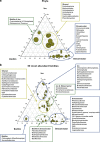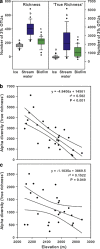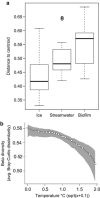Microbial biodiversity in glacier-fed streams
- PMID: 23486246
- PMCID: PMC3721114
- DOI: 10.1038/ismej.2013.44
Microbial biodiversity in glacier-fed streams
Abstract
While glaciers become increasingly recognised as a habitat for diverse and active microbial communities, effects of their climate change-induced retreat on the microbial ecology of glacier-fed streams remain elusive. Understanding the effect of climate change on microorganisms in these ecosystems is crucial given that microbial biofilms control numerous stream ecosystem processes with potential implications for downstream biodiversity and biogeochemistry. Here, using a space-for-time substitution approach across 26 Alpine glaciers, we show how microbial community composition and diversity, based on 454-pyrosequencing of the 16S rRNA gene, in biofilms of glacier-fed streams may change as glaciers recede. Variations in streamwater geochemistry correlated with biofilm community composition, even at the phylum level. The most dominant phyla detected in glacial habitats were Proteobacteria, Bacteroidetes, Actinobacteria and Cyanobacteria/chloroplasts. Microorganisms from ice had the lowest α diversity and contributed marginally to biofilm and streamwater community composition. Rather, streamwater apparently collected microorganisms from various glacial and non-glacial sources forming the upstream metacommunity, thereby achieving the highest α diversity. Biofilms in the glacier-fed streams had intermediate α diversity and species sorting by local environmental conditions likely shaped their community composition. α diversity of streamwater and biofilm communities decreased with elevation, possibly reflecting less diverse sources of microorganisms upstream in the catchment. In contrast, β diversity of biofilms decreased with increasing streamwater temperature, suggesting that glacier retreat may contribute to the homogenisation of microbial communities among glacier-fed streams.
Figures





Similar articles
-
Microbial assemblages reflect environmental heterogeneity in alpine streams.Glob Chang Biol. 2019 Aug;25(8):2576-2590. doi: 10.1111/gcb.14683. Epub 2019 Jun 17. Glob Chang Biol. 2019. PMID: 31077498
-
Benthic Biofilms in Glacier-Fed Streams from Scandinavia to the Himalayas Host Distinct Bacterial Communities Compared with the Streamwater.Appl Environ Microbiol. 2022 Jun 28;88(12):e0042122. doi: 10.1128/aem.00421-22. Epub 2022 Jun 8. Appl Environ Microbiol. 2022. PMID: 35674429 Free PMC article.
-
Ecological "Windows of opportunity" influence biofilm prokaryotic diversity differently in glacial and non-glacial Alpine streams.Sci Total Environ. 2024 Sep 20;944:173826. doi: 10.1016/j.scitotenv.2024.173826. Epub 2024 Jun 10. Sci Total Environ. 2024. PMID: 38866149
-
Microbial ecology of mountain glacier ecosystems: biodiversity, ecological connections and implications of a warming climate.Environ Microbiol. 2017 Aug;19(8):2935-2948. doi: 10.1111/1462-2920.13766. Epub 2017 May 30. Environ Microbiol. 2017. PMID: 28419666 Review.
-
Biodiversity, community structure and function of biofilms in stream ecosystems.Res Microbiol. 2015 Dec;166(10):774-81. doi: 10.1016/j.resmic.2015.05.006. Epub 2015 May 29. Res Microbiol. 2015. PMID: 26027773 Free PMC article. Review.
Cited by
-
Comparison of Environmental and Culture-Derived Bacterial Communities through 16S Metabarcoding: A Powerful Tool to Assess Media Selectivity and Detect Rare Taxa.Microorganisms. 2020 Jul 27;8(8):1129. doi: 10.3390/microorganisms8081129. Microorganisms. 2020. PMID: 32727027 Free PMC article.
-
Deciphering the comprehensive microbiome of glacier-fed Ganges and functional aspects: implications for one health.Microbiol Spectr. 2025 Aug 5;13(8):e0172024. doi: 10.1128/spectrum.01720-24. Epub 2025 Jul 7. Microbiol Spectr. 2025. PMID: 40621926 Free PMC article.
-
Biogeography and Diversity of Freshwater Bacteria on a River Catchment Scale.Microb Ecol. 2019 Aug;78(2):324-335. doi: 10.1007/s00248-019-01323-9. Epub 2019 Jan 28. Microb Ecol. 2019. PMID: 30687882
-
Geochemically Defined Space-for-Time Transects Successfully Capture Microbial Dynamics Along Lacustrine Chronosequences in a Polar Desert.Front Microbiol. 2022 Jan 31;12:783767. doi: 10.3389/fmicb.2021.783767. eCollection 2021. Front Microbiol. 2022. PMID: 35173689 Free PMC article.
-
Ecological networks reveal contrasting patterns of bacterial and fungal communities in glacier-fed streams in Central Asia.PeerJ. 2019 Sep 17;7:e7715. doi: 10.7717/peerj.7715. eCollection 2019. PeerJ. 2019. PMID: 31576247 Free PMC article.
References
-
- Anderson MJ, Ellingsen KE, Mcardle BH. Multivariate dispersion as a measure of beta diversity. Ecol Lett. 2006a;9:683–693. - PubMed
-
- Anderson MJ. A new method for non-parametric multivariate analysis of variance. Austral Ecol. 2001;26:32–46.
-
- Anderson MJ. Distance-based tests for homogeneity of multivariate dispersions. Biometrics. 2006b;62:245–253. - PubMed
-
- Anesio AM, Laybourn-Parry J. Glaciers and ice sheets as a biome. Trends Ecol Evol. 2012;27:219–225. - PubMed
Publication types
MeSH terms
Substances
Grants and funding
LinkOut - more resources
Full Text Sources
Other Literature Sources

